Amazing Tour Around Vesuvius and Pompeii
Italy is a country steeped in rich history, cultural heritage, and breathtaking natural landscapes. One of the most captivating destinations within this Mediterranean haven is the magnificent Mount Vesuvius and the ancient city of Pompeii. An excursion to this region promises an unforgettable experience that seamlessly blends the allure of history, adventure, and natural beauty.
Mount Vesuvius: A Majestic Force of Nature
Standing proudly at over 4,000 feet, Mount Vesuvius is one of the most renowned and dangerous volcanoes in the world. Located on the Gulf of Naples in Campania, southern Italy, this iconic stratovolcano has left an indelible mark on history due to its cataclysmic eruption in 79 AD, which buried the cities of Pompeii and Herculaneum in layers of ash and pumice.
Today, guided tours around Mount Vesuvius provide a unique opportunity to witness the sheer power and beauty of this still-active volcano. Trekking up the rugged terrain rewards visitors with breathtaking panoramic views of the picturesque Bay of Naples, the sprawling cityscapes below, and the vast expanse of the Tyrrhenian Sea.
The Enigmatic Ruins of Pompeii
Adjacent to Mount Vesuvius lies the ancient Roman city of Pompeii, frozen in time by the eruption nearly two millennia ago. The ruins of Pompeii offer an extraordinary glimpse into the daily life, architecture, and culture of the Roman Empire. Exploring the remnants of this once-thriving city allows visitors to immerse themselves in a captivating narrative of the past.
Wandering through the remarkably preserved streets, homes, and public buildings, visitors can envision the lives of ancient Pompeiians, from the opulent villas of the elite to the humble abodes of the common folk. The haunting yet compelling remnants of the amphitheater, the forum, and the House of the Faun are testaments to the magnificence of Roman engineering and artistry.
A Comprehensive Tour Experience
Embarking on an amazing tour around Vesuvius and Pompeii offers an immersive experience that caters to the diverse interests of travelers. Whether one is an avid history enthusiast, an intrepid adventurer, or simply a nature lover, this excursion presents a harmonious blend of archaeological wonders and scenic beauty.
Visitors can indulge in local culinary delights, savoring the authentic flavors of Neapolitan cuisine while basking in the warmth of Italian hospitality. Moreover, the region's renowned vineyards offer a chance to sample some of the finest wines, adding a delightful touch to the overall journey.
Preserving the Legacy
While the remarkable sites of Mount Vesuvius and Pompeii continue to enthrall visitors from around the globe, efforts to preserve and protect these invaluable historical treasures remain imperative. Ongoing conservation initiatives and meticulous archaeological research aim to safeguard these ancient marvels for generations to come, allowing future travelers to experience the captivating legacy of this extraordinary region.
In conclusion, a tour around Mount Vesuvius and Pompeii is an enriching and awe-inspiring journey that transcends time and space. It serves as a testament to the enduring resilience of human history and the enduring power of nature, leaving an indelible imprint on the hearts and minds of all who venture to this remarkable corner of the Italian landscape.
Full Day Tour: Pompeii, Herculaneum, and Vesuvius
Embark on a captivating journey through history, exploring the renowned sites affected by the catastrophic eruption of Vesuvius in 79 AD.
Overview
Experience the wonder of a "full immersion" in the historical locations associated with the eruption of Vesuvius in 79 AD.
Details
Discover the fascinating history of Pompeii, Herculaneum, and the Vesuvius volcano, all in one remarkable day. These archaeological sites have retained their unique characteristics, artworks, and architecture despite the destructive force of the ancient eruption. This tour offers you the opportunity to explore these UNESCO World Heritage Sites at your own pace, free from stress and long queues.
The History of Vesuvius and Pompeii
The history of Mount Vesuvius and the ancient city of Pompeii is a tale of natural disaster and archaeological discovery. Located in the Campania region of Italy, Mount Vesuvius is perhaps one of the most famous volcanoes in the world, thanks to its devastating eruption in 79 AD, which buried the nearby city of Pompeii. This cataclysmic event provides a window into the past, allowing us to understand the daily lives of ancient Romans in remarkable detail.
The Eruption of Mount Vesuvius
The eruption of Mount Vesuvius in 79 AD was a catastrophic event that has left a lasting mark on history. The eruption, which is believed to have occurred in late August or early September of that year, unleashed a torrent of ash, pumice, and hot gases that rained down on Pompeii, Herculaneum, and other nearby towns. The eruption was so powerful that it spewed a massive column of ash and debris high into the atmosphere, which then collapsed and caused a series of pyroclastic surges, burying the towns under meters of volcanic material.
The people of Pompeii and Herculaneum had little warning before the eruption. The towns were buried so quickly that many of the inhabitants were unable to escape. Their homes, belongings, and even their bodies were preserved beneath the layers of ash and pumice, creating a unique time capsule for archaeologists to study.
Rediscovery and Excavation
Pompeii remained buried and forgotten for over 1,500 years until its accidental rediscovery in the 16th century. During the construction of an aqueduct, workers stumbled upon the ancient city's ruins. However, it wasn't until the 18th century that systematic excavations began. The ruins of Pompeii, along with nearby Herculaneum and other affected areas, have since become one of the most important archaeological sites in the world.
Archaeologists have uncovered a wealth of information about the daily life of the ancient Romans by studying Pompeii's ruins. The city's well-preserved buildings, streets, and artifacts provide insights into Roman architecture, art, cuisine, and even social structure. The casts of human bodies created by filling the voids left by decomposed bodies with plaster have also offered a haunting glimpse into the final moments of the city's residents.
The Legacy of Pompeii
The eruption of Mount Vesuvius and the subsequent excavation of Pompeii have had a profound impact on our understanding of ancient history. The city's preservation in volcanic ash has allowed us to piece together a remarkably detailed picture of life in the Roman Empire during the 1st century AD. We have learned about their customs, art, and daily routines, shedding light on a world that would have otherwise been lost to time.
Today, Pompeii is a UNESCO World Heritage Site, drawing millions of visitors from around the globe who come to marvel at its ancient streets and buildings. It serves as a testament to the power of nature and the resilience of humanity in the face of disaster.
Conclusion
The history of Vesuvius and Pompeii is a captivating tale of natural destruction and human discovery. The eruption of Mount Vesuvius in 79 AD forever changed the course of history, preserving the ancient city of Pompeii beneath layers of ash and pumice. Its rediscovery and excavation have provided invaluable insights into the lives of the Romans who lived there, making Pompeii one of the most important archaeological sites in the world.
Naples: Pompeii and Herculaneum Unveiled
Embark on a captivating journey through the remnants of Pompeii and Herculaneum, two ancient Roman cities frozen in time by the eruption of Mount Vesuvius in 79 AD. This exclusive walking tour, led by a private guide or in a small group, unveils the highlights of these archaeological wonders.
Explore the echoes of Pompeii's glorious past, immersing yourself in the daily life of ancient Romans. Feel the pulse of the city as it thrived before the catastrophic events that buried it in volcanic ash.
As you traverse the well-preserved streets, envision the splendor of Pompeii and Herculaneum, gaining a profound understanding of their historical significance. Marvel at the intricate details of the archaeological sites, brought to life by the expertise of your guide.
Our carefully curated experience allows you to step into the shoes of an ancient Roman, providing insights into the cultural richness and architectural marvels that once defined these cities.
With the flexibility to cancel up to 24 hours in advance, this tour ensures peace of mind for your travel plans. No need to worry about tickets—skip the line and delve straight into the immersive exploration of these archaeological gems.
Rest assured, your health and safety are paramount. Special Covid-19 precautions are in place, outlined in your activity voucher for comprehensive details.
Duration: 5.5 hours
Language options: Spanish, English, Italian, French, German, Russian, Chinese, Japanese, Portuguese
Join us on this private journey, and witness Pompeii and Herculaneum as they come alive once again.
The Natural Beauty Around Vesuvius: Pompeii and its Surroundings
Pompeii, a city frozen in time, is perhaps best known for its tragic encounter with the eruption of Mount Vesuvius in 79 AD. However, beyond the historical tragedy lies a rich tapestry of natural beauty that surrounds this ancient city.
Mount Vesuvius: The mighty volcano, Mount Vesuvius, is an ever-present natural wonder in the vicinity of Pompeii. This stratovolcano, which last erupted in 1944, not only represents a source of danger but also a source of geological fascination. It offers breathtaking panoramic views from its summit, attracting hikers and nature enthusiasts from around the world.
The Bay of Naples: The stunning Bay of Naples stretches out before Pompeii, offering an expanse of blue waters that contrast with the dark volcanic soil. It's a haven for boaters, with the picturesque towns of Sorrento and Positano lining its shores. The bay's beauty is a testament to the power of nature's ability to rejuvenate and sustain life, even in the shadow of a deadly volcano.
| Local Flora and Fauna |
Archaeological Treasures |
- The fertile soil around Vesuvius supports a rich variety of vegetation, including vineyards, olive groves, and citrus orchards.
- The Mediterranean climate in the region nurtures colorful flowers such as bougainvillea, wisteria, and caper plants.
- The bay and the coastline are home to a diverse range of marine life, making it a great spot for snorkeling and diving.
|
- Pompeii's archaeological site is a time capsule that preserves not just ancient buildings but also details of daily life, such as frescoes and mosaics depicting nature scenes.
- The gardens of Pompeii, known as "horti," were beautifully landscaped with fountains and adorned with statues and sculptures of mythological creatures.
- The casts of people who perished during the eruption provide poignant insight into the human connection with nature during this tragic event.
|
The Healing Springs of Pompeii: Hidden amidst the ruins of Pompeii, you can find ancient thermal baths. These natural hot springs were crucial to the well-being of the ancient Pompeiians, and they believed that the mineral-rich waters had healing properties.
Pompeii's Vineyards: The volcanic soil around Vesuvius is a boon for viticulture. The region is known for producing distinctive wines like Lacryma Christi (Tears of Christ). The vines are not only a source of wine but also a living link to the agricultural practices of the past.
When exploring the archaeological site, it's easy to get lost in the labyrinth of ancient streets, houses, and public buildings. Amidst this intricate web, you'll encounter the remnants of gardens and courtyards, where Romans cultivated plants, further connecting the people of Pompeii to the natural world.
Visiting Pompeii and its surroundings offers a unique opportunity to delve into the intertwining narratives of history and nature. The tragic eruption of Mount Vesuvius, which took so much, also gave us a preserved glimpse of life in ancient times and the enduring power of the natural world.
In conclusion, while Pompeii's historical significance is undeniable, the nature around Vesuvius and the Bay of Naples adds a layer of allure and fascination that should not be overlooked. From the grandeur of Mount Vesuvius to the simplicity of a blooming flower amidst ancient ruins, the natural beauty in this region stands as a testament to the resilience and wonder of the natural world.

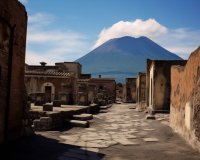
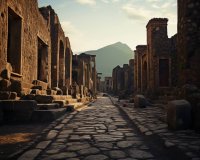
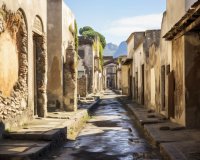
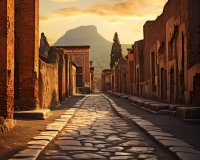
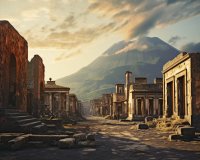
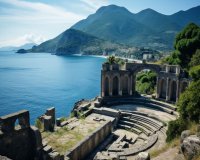
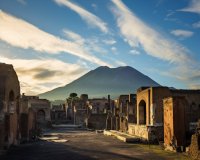
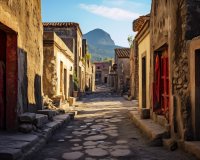
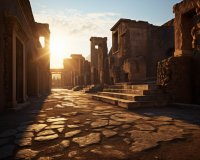
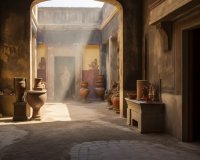
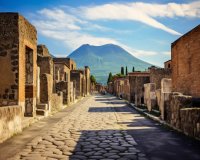
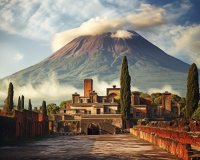
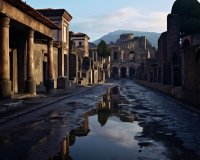
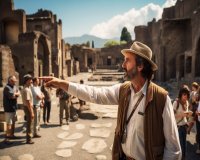
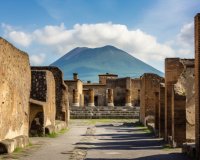
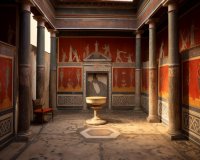

 A Child-Friendly Guide to Pompeii: Making History Fun
A Child-Friendly Guide to Pompeii: Making History Fun
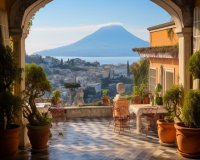 The Best Spots for Limoncello Tasting in Sorrento After Pompeii
The Best Spots for Limoncello Tasting in Sorrento After Pompeii
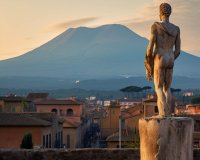 Discover Pompeii and Vesuvius in a Day Trip
Discover Pompeii and Vesuvius in a Day Trip
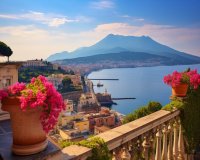 The Wonders of Sorrento: Discovering Pompeii and Vesuvius on Your Journey
The Wonders of Sorrento: Discovering Pompeii and Vesuvius on Your Journey